

Beyond Greed and Fear Understanding Behavioral Finance and the Psychology of Investing (Financial Management Association Survey and Synthesis)
J**N
Five Stars
interesting and useful!
W**S
A classic!
For everyone interested in a really good overview in the findings of behavioral finance: this is the one to read! Shefrin does a great job with this book!
R**S
Great Purchase
It was worth spending on the book to understand the key concepts of behavioural finance. I would recommend it for those who don't understand finance concepts to get to terms with the theory.
F**L
Old and tired
When this book was first published, it may have been an eye opener to the non-academic audience it seems to have been aimed at. Now that behavioural finance is widely accepted, and there are other books for the general reader, its weaknesses become obvious.This is a book from the "I'm clever and everyone else is stupid" school of writing - and the author is not as good a writer as Nicholas Taleb. As one small example, we are encouraged to sneer at people who have chosen the wrong model of the market (e.g. momentum players or contrarian players), without any hint that the author has any techniques or analysis to determine which model to use when, and with a strong "they are wrong 50% of the time" attitude.The book does not cover today's full spread of behavioural finance. We have issues around "framing" well explained and explored. The tendency for people to minimise regret rather than maximise wealth, the power of recent memory, and the mis-use of mental models are all covered, but the chain from psychology to these symptoms is not really mapped or explored.And then the second half of the book is taken up with examples of market inefficiency, with no real explanation of the causes, and no real attempt to link these to human behaviour.For the academicly-minded, the references are pulled from a surprisingly small group of authors - though it was probably not so surprising given when the book was written. And for the general reader it suffers from not having a narrative thread that builds through the book.No doubt a 5-star book when first published; now there are so many other books out there there must be many better. I am starting in to James Montier "Behavioural Investing" - and so far so good.
M**D
A readable introduction to Behavioural Finance.
A sensible and readable introduction to Behavioural Finance for investors. Shefrin first discusses the behavioural biases exhibited by investors and then shows how these are to be found in a wide range of investment activities - efforts to predict the market, individual and institutional investors, corporate finance and derivatives.The books is interesting to read and contains several real life examples of the unfortunate effects of the biases (such as the Long Term Capital Management).Not a book for academics but for anyone interested in why investment decisions so often go wrong this will provide an excellent introduction.
A**S
GENIAL!!!
Eigentlich bin ich, was die Behavioral Finance angeht ein großer Fan von Robert Shiller, aber was Shefrin hier in seinem Buch aufzeigt ist mindestens ebenbürtig. Ich kann das Buch jedem empfehlen der mehr wissen will über die Entscheidungen und die Verhaltensmuster an der Börse. Fernab der klassischen Kapitalmarkttheorien geht es hierbei wirklich hauptsächlich darum die Psyche der Anleger zu verstehen und daraus für sich Schritte abzuleiten, um ein besserer Investor zu werden. Für jeden Anleger ein tolles Buch und für alle die den Kapitalmärkten gegenüber noch skeptisch sind auch!
F**O
Five Stars
good book
A**O
Human Behaviour
Three themes are the common thread throughout this book.Heuristic-driven Bias is one of them. It includesAvailability Bias, Hindsight Bias, Familiarity Bias,Rule of 5, 1/n-rule (naive diversification), Over-confidenceand Optimism.Aversion to Loss and Aversion to Ambiguity; representative-ness, Consevatism due to Anchoring-and-(lack of) adjustment,Illusion to Validity are also discussed in this book.I do not agree with the Gamblers' Fallacy in the stockmarket. The stock market was compared to the tossing ofa coin. They are different. As the market rises, the risksof a correction or a bear definitely increases whereas theprobability of tossing a coin to land a head of tail isconstant all the time.Hindsight Bias was not well defined in this book. This booksaid there are more male traders than women (75% to 25%).Surprisingly, women make better traders, albeit only slightly.By the next edition, I look forward to more 'meat' in the book.Practical application ideas seem insufficient here. It isa book more for you to understand human behaviour in thestock market. A worthwhile read.
購**者
Behavioral Finance の実務家向けの実用書
Behavioral Finance の実務家向けの実用書。ファイナンスの本としては珍しく、数式が一つも出ていない。Behavioral Finance 研究をまとめて、それから経済学的なものを取り去り、実務家のレッスン用にまとめるとこんな本ができるのだろう。投資家の立場から見るとこの手の本は手軽でいいのかもしれない。
N**M
Un vrai mémoire de recherche sur le sujet
Une théorie entre trois actes sur la perception de l'évolution des marchés, l'influence de celle-ci sur les marchés et la subjectivité du risque tel que perçu. Enfin tout cela est psychologique n'est-ce pas? On pense aussi à la reflexivité, autre théorie récente. Pas trop facile à lire cependant. mais de nombreux exemples en rendent la lecture agréable et instructive.
Trustpilot
2 days ago
1 month ago